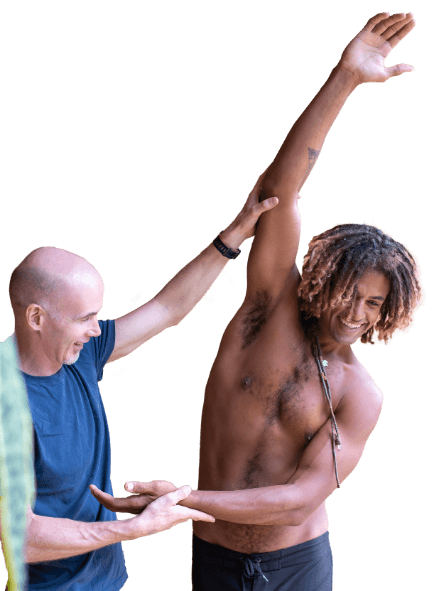
Understanding Disc Bulges and Herniations
Up to 85% of us will experience back pain at some point in our lives. For most, this pain is temporary and resolves within a few days. It is often caused by a pulled muscle or ligament. However, for some, the pain may be the result of a disc bulge or herniation.
In a disc herniation, the gel-like liquid at the center of the disc, known as the nucleus pulposus, is squeezed out of the surrounding ring, much like jam being squeezed out of a doughnut. This “jam” can then push on the nearby nerves, causing inflammation, which leads to pain that radiates down the leg, a condition known as sciatica.
Disc bulges and herniations are common when the joints of the lower spine are overused, such as in individuals who frequently bend forward or have tight hips, causing the lower back to compensate by moving more. While disc bulges are very common, they don’t always cause pain. For example, up to 84% of people in their 80s have disc bulges without any pain, but they sometimes do cause pain.
Some people may consider surgery for disc issues, but studies have shown that there is not much difference in long-term outcomes between those who undergo surgery (1) and those who do not. Dr. John Sarno, a renowned physician, believed that simply providing information and education could help many people overcome their back pain. (2)
While information is valuable, it doesn’t always relieve the pain. That’s why we’re going to explore four exercises that can help pump out inflammation, relax the muscles, and keep the spine strong and mobile.
This exercise involves lying on your back and using your breath and movement to mobilize the spine. Start by taking a deep breath, feeling your belly expand. As you exhale, allow your back to arch slightly off the ground. As you do this, let your knees drop outward, relaxing the muscles in the front of your body.
As you exhale, rotate your hands externally, pulling your shoulder blades together. Then, on the next inhale, rotate your hands inward. Repeat this sequence 5-8 times, moving slowly and in control to help pump out inflammation and improve mobility in the lower back and hips.
For this exercise, you’ll start by lying on your stomach, with your head turned to the side and your hand resting on the ground. Lift your head and chest off the ground using your upper back muscles rather than your lower back. This is important as it helps to avoid further straining the already irritated area.
Next, lift the opposite leg off the ground, focusing on pushing the pelvis down into the ground to stabilize the lower back. Avoid arching your lower back as you lift your leg. The key to this exercise is to engage your upper back and your glute but not extend or move your lower back too much. Repeat this movement 3-5 times on each side, then try lifting your whole arm off the ground as you lift your leg and head.
For this exercise, you’ll need a chair. Sit up tall, with your hands dangling down by your sides. Begin by rotating your hands backward, which will gently arch your lower back. Imagine there’s something on top of your head that you’re trying to push up towards the ceiling.
Next, rock to the back of your pelvis, flexing your spine and allowing your chin to come forward slightly. Avoid letting your ribs flare out. Repeat this sequence of arching and flexing your spine, breathing in and out 5-10 times. This exercise helps to mobilize the spine in both flexion and extension, complementing the previous lying-down exercises.
The final exercise is designed to help move or “floss” the nerves that may be irritated by the disc issue. Start by sitting up tall and extending one leg out in front of you, but don’t push into any pain. Just as far as you can go before you feel a stretch. Look up as you do this.
Next, breathe out and slowly slide your leg back to a normal sitting position, allowing your chin to tuck towards your chest. Then, repeat, as you breathe in, use your back muscles to extend your spine, look up towards the ceiling, and slide the leg out in front of you again.
Repeat this sequence of flexion and extension 10-15 times, focusing on keeping the movement smooth and controlled. You may feel some tension down the back of your leg, but the goal is to stay within a pain-free range of motion. Repeat on the other side.
Remember, these exercises are designed to help pump out inflammation, relax the muscles, and improve mobility in the spine and surrounding areas. If you have any specific concerns or questions, don’t hesitate to reach out to a healthcare professional for personalized guidance.
I hope you found this information helpful. If you want my help to see if we can use specific exercises and lifestyle medicine to help you recover from pain, injury, or illness please reach out to me via ed@edpaget.com

Over the last 10 years Ed has been building a YouTube library to help people manage their own pain or movement limitations and increase performance through exercise. He regularly adds videos so be sure to subscribe and visit regularly


"Oh My Gosh- I am ALREADY feeling relief after a few days! I used to wake up 2-3 times a night with shooting pain that anti inflammatories couldn't touch. Now I have been waking up just because I want to notice what it feels like to lay in bed pain free- THANK YOU!."

"When I first started with your program I was experience a lot of pain. Walking was difficult. I had to stop and catch my breath every few minutes and lean against a wall for support. Now when I walk with my husband we go for over an hour. I never had to sit down and stop...and, hardly any pain!!! 😊😊 I can’t thank you enough."
Frustrated that you aren't recovering fast enough?
Discover how to heal from illness and injury using movement, food and lifestyle.